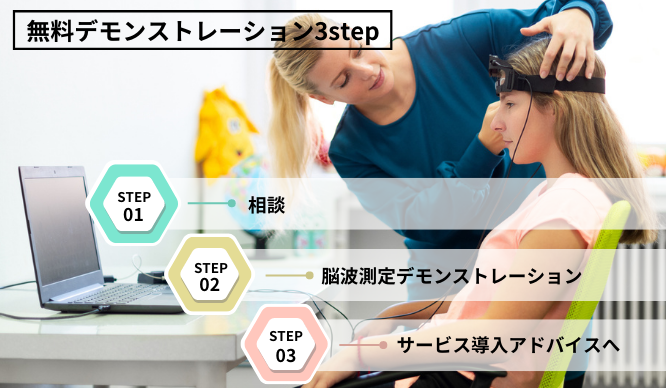新人技術者の脳波測定記 番外編(補足)

はじめに
脳波とは?EEG(イーイージー)とは?何がわかるの?
そんな状況からスタートした新人技術者が実際にEEGをさわってみて感じたことを掲載する”新人技術者の脳波測定記”。
予備知識なしで挑む生の声をお伝えしようと思います。
入力インピーダンスの考え方
”脳波計(EEG)の選び方”にて入力インピーダンスが大きいことにより、接触抵抗の影響度をさえることができると説明致しました。
今回は、脳波から一度離れで電気回路の復習をおこないたいと思います。
電気回路から見た脳波計
電気回路から見た脳波計の模式図は、下記の通りとなります。
脳活動によって活性化された数百万個のニューロン郡が発生させる電気信号が頭皮まで伝搬し、直上に取り付けられた脳波計のセンサーモジュールによって取り込まれる形となります。
R1がニューロンから電極のインピーダンス(固定値+接触インピーダンス)、R2が入力インピーダンス(脳波計内の抵抗)です。

図1.脳波計の電気回路模式図
計算してみよう
中学校でならったオームの法則、合成抵抗を思い出してみましょう。
電流 = 電圧 / 抵抗
合成抵抗 = (抵抗1 x 抵抗2) / (抵抗1 + 抵抗2)
でしたね。
では、具体的に当てはめてみましょう。
仮にニューロン郡から発生する電気信号の電位差(基準点と測定点の電位差)が10uVとします。
人体のインピーダンスは約1KΩ、今回は接触抵抗を0Ωとして計算します。
この時点で電極間に流れる電流は、
10uV / 1KΩ = 0.01uA
となります。
仮に、脳波計の入力インピーダンスが10MΩであれば、
合成抵抗は、
(1K x 10M) / (1K + 10M) = 999.9Ω
となり、観測される電圧は、
0.01uA x 999.9Ω = 9.999uV
となり誤差はほとんど生じません。

図2.入力インピーダンスが大きい場合
では、入力インピーダンスが10KΩ、1KΩの場合同じ計算をしてみましょう。
(1K x 10K) / (1K + 10K) = 909Ω
(1K x 1K) / (1K + 1K) = 500Ω
つまり、観測される電圧は、
入力インピーダンスが10KΩ時:
0.01uA x 909Ω = 9.09uV
入力インピーダンスが1KΩ時:
0.01uA x 500Ω = 5uV
となります。
入力インピーダンスが小さい場合、誤差が大きくなることを実感頂けたと思います。

図3.入力インピーダンスが10kΩの場合

図4.入力インピーダンスが1kΩの場合
まとめ
結果からご理解頂けると思いますが、
・入力インピーダンスがニューロンから電極のインピーダンス(固定値+接触抵抗)に比べて十分に大きい場合、
測定誤差が無視できるレベルに低下する
・入力インピーダンスが十分に大きい場合、接触抵抗が多少大きくなっても影響度合いを抑えることができる
・ニューロンから電極のインピーダンスのうち接触抵抗が変数なので、入力インピーダンスを大きくすることができない場合、
接触抵抗を小さくする努力が必要になる
と言えます。
無料デモンストレーションのご案内
実際に脳波を計測してみませんか?
脳波をベースにした「熟練者の技能伝承」とは?
脳波ベースにした人間の意識、判断を学習するAIとは?
不明なことが多いかと思いますので、まずは脳波を測定してどんなものか体験してみませんか?
ご興味ある方は下記ボタンより詳細をご確認ください。
お問い合わせ
本記事に関してご質問がありましたら、以下より問い合わせください。
InnerEye メーカー情報Topへ
InnerEyeメーカー情報Topページへ戻りたい方は、以下をクリックください。
免責および情報の利用
本ページは予告なく変更することがあります。
脳科学は日々新しい研究成果が発表されている分野です。
情報の正確性について万全を期しておりますが、掲載されている内容が最新の研究成果にそぐわない場合もございます。
様々な論文をご参照の上総合的にご判断下さい。
また、本ページに掲載されている内容をもとに作成されたプログラムに対して責任を負いかねますので予めご了承ください。



